READER COMMENTS ON
"Diebold Profit Falls By 46%"
(34 Responses so far...)
COMMENT #1 [Permalink]
...
Peg C
said on 7/27/2006 @ 9:39 am PT...
I think I would do a Pew Research analysis before concluding that wool is necessarily being draped across everyone's eyes. Later...I'll let you know. 
COMMENT #2 [Permalink]
...
Winter Patriot
said on 7/27/2006 @ 9:43 am PT...
Peg: if RLM is right --- and I think he is --- the wool won't do anything to hide the smell.
COMMENT #3 [Permalink]
...
mr.ed
said on 7/27/2006 @ 10:06 am PT...
Are they still on Jim Cramer's BUY! list? Hmmmmm?
COMMENT #4 [Permalink]
...
Robert Lockwood Mills
said on 7/27/2006 @ 10:50 am PT...
For Mr. Ed: Cramer's game is to hype a stock and then watch the stock rise BECAUSE HE RECOMMENDED IT, by a self-fulfilling prophecy.
When Cramer recommended Diebold the stock was around 40. It went to 46. So Cramer was right! Except his recommendation was the trigger for the stock's rally, after which it dropped to 38. So traders made money off Cramer, but investors who held the stock didn't. Now...ask yourself, "Who buys the stocks Cramer hypes, traders or investors?"
I promise you it's traders. Can anyone imagine a mutual fund portfolio manager, or the top investment guy at New York Life, or the head of CALPERS Investment Committee, basing a decision on what that clown says? Cramer is an example of how even a stuffy business like stocks and bonds can become the business equivalent of "Crossfire."
COMMENT #5 [Permalink]
...
Peg C
said on 7/27/2006 @ 11:30 am PT...
I just got back from doing a hasty market analysis on Diebold, and the results are appalling. S&P, which decribes it as an "information technology" and "hardware" company rates it as an A-. Market analyst consensus rates it as a "Buy."
Now, if you hadn't been following the evoting issue and were just a Schmoe off the street looking to invest a few bucks, you'd think Diebold looked pretty good! Aaaargh!!!!
COMMENT #6 [Permalink]
...
oldturk
said on 7/27/2006 @ 11:33 am PT...
One can hope that the entanglements of protracted litigation bring this FASCIST MONSTER - DIEBOLD to the point of their eventual demise.
Kennedy/Papantonio will behead this Diebold monster with the chainsaw of litigation. Hopefully they won't stop there,.. Sequoia and ES&S should also be dragged into the inferno of the courthouse. How these privately owned business concerns were allowed to
hijack and make a mockery of our Democracy is beyond
comprehension. Hopefully that is a question Representative Robert Ney (R-OH) will be made to answer.
Our IMPERFECT DEMOCRACY has been subverted by avaricious gluttony - so that our political systems have become akin to that of a third world Banana Republic - FASCIST DICTATORSHIP.
Hopefully the United States of America citizenry will
come to realize the dark quandary we are in. Immediate
and direct action is required that we put our heads together,.. put partisanship aside,.. and put the
IMPERFECT LOCO-MOTIVE OF DEMOCRACY back
on to the rails and tracks. It will take years of our
working together in unison to reverse the damage this
selfish,.. gluttonous,.. avaricious,.. corporatist
FASCIST REGEIM has placed us in. May our tomorrows recognize the mistakes of our yesterdays in-order that this coup detat upon our cherished
DEMOCRACY is never allowed to be reiterated again,... during this generation,.. and the next,.. and the next,.. and the next,... and the next
after that. We owe the children of this world the legacy of a better gift than than the annihilation and destruction of the political system we call
DEMOCRACY. Who hates America,.. who hates the
World,.. to deny us that ? They belong confined to a straight jacket and a padded cell on the looney farms.
COMMENT #7 [Permalink]
...
Bluebear2
said on 7/27/2006 @ 11:51 am PT...
Hey guys -
You missed that moldy patch a little to the right of the butter!
COMMENT #8 [Permalink]
...
Winter Patriot
said on 7/27/2006 @ 11:54 am PT...
Moldy patch? You mean OHIO?
COMMENT #9 [Permalink]
...
oldturk
said on 7/27/2006 @ 11:59 am PT...
BB-2
Everything looks to be delectable on the left,.. side.
COMMENT #10 [Permalink]
...
Robert Lockwood Mills
said on 7/27/2006 @ 12:21 pm PT...
For Peg C: The financial media (including rating agencies like Value Line) are just the same as Wall Street...amoral. Their primary source for information about the companies they report on is, guess who? The companies themselves! In Diebold's case, they told the analysts what they wanted to tell them. Period.
Whenever a company is sued for any reason, the immediate response is always the same. "The suit is without merit." You can search corporate records back to Commodore Vanderbilt and never find a company making a statement like, "They caught us red-handed. Give them credit. We're guilty, and they caught us."
If an analyst had asked Diebold, "What about the suits that were filed against you?" the response would have been non-committal or "...without merit." So by error of omission this stuff gets left out of analysts' reports and news stories based on those reports.
But here's the sticky wicket for Diebold: IN A PROSPECTUS, you can't play the same game. Any legal action against the company must be detailed, for the benefit of potential investors. A prospectus would be required for any bond refinancing, issuance of new stock or new stock-option program, or any corporate change such as a spin-off of a division (e.g. election machinery), merger, or acquisition. If the RFK, Jr. suit (or any of the other pending suits) have identified deliberate misstatements in a prospectus, that will be doubly ruinous to Diebold. If the fraud involves statements that accompany earnings announcements, then omissions aren't penalized but any misleading "forward looking" statement may be.
COMMENT #11 [Permalink]
...
Bluebear2
said on 7/27/2006 @ 1:02 pm PT...
WP #8
And spreading down through DC.
Old Turk - With peanut butter and strawberry jam!
COMMENT #12 [Permalink]
...
Dredd
said on 7/27/2006 @ 1:42 pm PT...
Diebold Election Systems, Inc. (DESI) is not the same corporation as Diebold, Inc. (DI).
Diebold, Inc. is an Ohio corporation, original #1276, incorporated in 1876 (yep, 130 yrs old).
Diebold Election Systems, Inc., is a Delaware corporation, but has an Ohio charter registration number of #1181841, with the registration date of August 29, 2000 (6 yrs old).
COMMENT #13 [Permalink]
...
Dredd
said on 7/27/2006 @ 1:49 pm PT...
Oldturk #6
Diebold, Inc. is not private, it is a publicly traded corporation, isn't it?
Otherwise it would not be on the stock exchange would it?
Diebold Elections Systems, Inc., a different corporation, is another question ... RLM?
COMMENT #14 [Permalink]
...
Laura
said on 7/27/2006 @ 1:49 pm PT...
That sure is convenient, registered just for the 2000 vote debacle to usher in the 4th reich!
COMMENT #15 [Permalink]
...
Winter Patriot
said on 7/27/2006 @ 2:02 pm PT...
So what are you saying, Dredd?
Have I got this all screwed up??? ;-(
COMMENT #16 [Permalink]
...
big dan
said on 7/27/2006 @ 2:25 pm PT...
OOPS!
btw...how can an entity involved in our democracy, be in the "profit sector" anyway??? That means, profits are #1, and democracy is #2, doesn't it? Much like the mainstream media...profits #1, news #2...
COMMENT #17 [Permalink]
...
Bluebear2
said on 7/27/2006 @ 3:03 pm PT...
Is Diebold voting not owned by Diebold Inc.?
That was what I thought.
COMMENT #18 [Permalink]
...
JStraight
said on 7/27/2006 @ 3:21 pm PT...
We're doing our part in Utah to get out the word that Diebold IS in fact a voting machine company. Bruce Funk, who served as Emery County Clerk for 23 years will be speaking TONIGHT in Salt Lake City about his recent experience discovering the problems with the Diebold TSx machines his county received earlier this year. More info about his talk here: http://utah-vote.blogspot.com/
COMMENT #19 [Permalink]
...
Dredd
said on 7/27/2006 @ 3:43 pm PT...
Laura #14
That linkage is where it is at. A massive effort to destroy the USA without hurting it is what we are talking about.
By that I mean ... neutron bomb ... only kills or contaminates flesh ... does not damage machines ...
EVM bomb only destroys the voting public's will ... not the dollars and "goodies" ...
Laura ... gooooooood "eyes" !!!!
WP I love ya man ... I really do ...
COMMENT #20 [Permalink]
...
Bluebear2
said on 7/27/2006 @ 4:07 pm PT...
" Penicillin. The printing press. The personal computer. These milestones of progress improved society forever. Now it’s democracy’s turn.
Diebold Election Systems ensures accurate vote counting, extremely reliable security, and accessibility for every voter.
Over 80,000 Diebold electronic voting stations are being used in locations across the United States to assist voters in exercising their most fundamental constitutional right: the right to vote.
Every vote counts. Let’s count every vote. Choose Diebold Election Systems.
Diebold takes pride in our industry leading accessibility, security and accuracy.
Industry Leading Security
The foundation of Diebold Election Systems’ security includes several layers of physical and digital safeguards and multiple audit trails including both digital and voter-verifiable paper audit trails.
Accurate and Reliable Results
Diebold Election Systems has several methods in place to ensure election accuracy. When a voter casts their ballot using the Diebold touch screen system, the ballot selections are immediately encrypted and stored in multiple locations within the voting station, providing security and reliable redundancy.
California Tests Find Diebold Touch-Screen Voting 100 Percent Accurate During November 2005 Election."
What's the matter with you librel whiners - can't you read? What r ya abunch of morans? Diebold - the best there is!
Help - I've been possessed!
Sheesh - I think it's passing!
Ah, that's better - must have been all the heat from the last 12 days!
Can you believe that crap? Or this: "California Tests Find Diebold Touch-Screen Voting 100 Percent Accurate During November 2005 Election."
What tests were those? - The ones where they just made a second read of the same rigged memory cards, and a third read just to really prove it?
COMMENT #21 [Permalink]
...
Bluebear2
said on 7/27/2006 @ 4:25 pm PT...
Dredd #12
Winter #15
Me #17
At the bottom of the page on the Diebold Elections Systems, Inc. link I just posted is the wording:
"Copyright 2006 Diebold, Inc." - when clicked on it brings up the home page for Diebold, Inc. the ATM guys.
So I've answered my own question.
Here is their finacial report for the first quarter 2006. If you scroll down just past the "Full-year 2006 outlook" heading you can find entries for "Election Systems".
And also "Lottery Systems". Hmmm - maybe they confused the two!
COMMENT #22 [Permalink]
...
Peg C
said on 7/27/2006 @ 6:25 pm PT...
WP -
No, Diebold, Inc. ("DBD" on the NYSE) is the parent company, of which Diebold Election Systems is a subsidiary. So they can muddle it all together - sort of reminiscent of Enron. At least that's what a Google search told me.
COMMENT #23 [Permalink]
...
oldturk
said on 7/27/2006 @ 9:38 pm PT...
DREDD - Comment # 12
More info,.. for the "Private Sector"
Service and Vendor Business Entity
known as:
DIEBOLD and BAHMANN COMPANY 1859
AKA : DIEBOLD SAFE and LOCK COMPANY INC. 1876
AKA : DIEBOLD INC. (Parent & Subsidiaries) 1943
************
************
Diebold - history/date of inception.
1859 - Charles Diebold first organized Diebold Bahmann in 1859, as a manufacturer of safes and vaults in Cincinnati, Ohio.
1871 - In the wake of the 1871 Great Chicago Fire, natural disaster proved a boon for Diebold Bahmann & Co. when word spread that all 878 Diebold safes in the area, along with their contents, survived the flames.
1872 - In 1872 Diebold had outgrown its space in Cincinnati and transferred plant and headquarters to Canton, Ohio, where most of the post-fire orders were filled.
1874 - In 1874 Wells Fargo of San Francisco chose Diebold to make what would be the world's largest vault.
1875 - The following year, a special 47-car train transported the 32-foot-long, 27-foot-wide, 12-foot-high vault to San Francisco.
1876 - In 1876 the company was incorporated under Ohio law as Diebold Safe & Lock Co. The company was incorporated under the laws of the state of Ohio in August, 1876, succeeding a proprietorship established in 1859.
Photo of the "Big Kahuna"
Diebold Sale and Lock Company Inc.
http://en.wikipedia.org/...ldDieboldSafe2006-07.JPG
1890 - In 1890 the company introduced manganese steel doors that were billed as TNT-proof. Through time, combination locks replaced keys, which could be copied. Safety hinges were introduced along with locks that jammed automatically after banking hours.
1921 - Following the Wells Fargo feat, Diebold S&L Co. continued to traffic in the colossal, selling the largest-ever commercial bank vault to Detroit National Bank in 1921.
1930 - While better and more secure vaults and safes continued to be key features in Diebold S&L Co. product line, the market for safes and vaults has not always been dependable, relying as it does on the health of the banking industry. In the 1930s, Diebold S&L Co. began to diversify.
1936 - In 1936 the company acquired United Metal Products Co., also of Canton, a manufacturer of hollow metal doors and door frames.
1938 - In 1938 Diebold S&L Co. made its first entrance into the office equipment business by introducing the Cardineer Rotary File System.
1942 - Several factors motivated Diebold S&L Co. first expansion. World War II brought the safe and vault business as a whole out of rough years with a flurry of government armament contracts. Following the dismal economy of the 1930s, the war created a demand for manufacturers accustomed to high-precision work with hardened steels. For Diebold, as well as its main competitors York Safe and Mosler Safe Co., the war effort spelled a windfall. In 1942 Diebold, which had previously grossed around $3 million per year, brought in $40 million.
1943 - Amidst these acquisitions, in 1943 the company changed its name to DIEBOLD INCORPORATED to better reflect its diversified product line.
1944 - This was followed in 1944 with the acquisition of the Visible Records Equipment Company of Chicago, a former subsidiary and a manufacturer of vertical filing systems and other record-keeping equipment. That same year, Diebold bought the patents and manufacturing rights for Flofilm, a process that allowed companies to microfilm records in-house with a one-hour automatic developer.
1944 - Additional details - When the dust settled and the contracts disappeared with the end of the war, the company was fiscally sound but its executives were having trouble agreeing on Diebold's path of postwar reconversion. Amid the confusion, Eliot Ness joined the company's board in 1944. A former prohibition agent (of The Untouchables fame) and Cleveland director of safety, he represented the Rex family, who owned the largest single block of Diebold shares (38 percent). Ness, who became chairman of the board, engineered a spectacular takeover of York Safe. Located in York, Pennsylvania, York was the largest prewar producer of safes and vaults, with a strong sales base on the East Coast. However, the company had let its sales division deteriorate during the war, while Diebold's was intact. Seeing York's weakness, Diebold moved in. The deal came together with the help of Clint Murchison, Sr., a Texas oilman and a friend of future chairman Daniel Maggin. Murchison arranged for several insurance companies to make loans to Diebold for the purchase and personally guaranteed them. Diebold acquired all of York's patents, tools, service contracts, and orders as well as its sales branches. However, the York company had diversified to include plastics production and microfilm equipment and Diebold left the remaining business freestanding under the name York Industries, Inc.
1945 - In 1945, buying rights to the Safe-T-Stak Steel Storage File further augmented Diebold's growing office equipment business.
1946 - The following year, Diebold bought the safe and vault business of the York Safe & Lock Company.
1947 - In January 1947, the bank equipment division of O.B. McClintock Co. of Minneapolis went over to Diebold. The products acquired from McClintock included burglar alarms, a bank vault ventilator (in case of lock-ins), and after-hour depositories.
1954 - The company made a splash in 1954 by putting visually pleasing vault doors on the market. In the process of mechanically redesigning its bank vault equipment, the company canvassed bankers for suggested improvements to the standard. The overwhelming answer was that a plain slab of steel, particularly on the inside of the door--the side customers see--was an unworthy complement to a bank's carefully decorated public spaces. The company then hired Charles Deaton, a St. Louis industrial designer, to retool both the interior and exterior of the vaults. Despite the fact that the newly designed vaults cost around twice as much as the simpler models, they dominated new orders from customers.
1964 - Diebold was first listed on the New York Stock Exchange in April 1964, under the symbol DBD.
1950 - 1957 - In the 1950s, Diebold cashed in on America's postwar migration to suburban areas, which created a demand for new bank branches and orders for safes as well as the full complement of office and security equipment. Thanks to its expansion during the 1940s, the company was able to meet the new demand for its products. The automobile-oriented suburban life brought buyers for the company's drive-in teller windows, which Diebold had started selling after the purchase of McClintock, along with the Diebold-McClintock burglar alarm and several models of after-hour depositories. In 1955 Diebold acquired K. F. Kline Co., a maker of steel lockers, shelving parts, storage bins, and storage and wardrobe cabinets. The Kline acquisition, combined with Diebold's previous business in record-handling and storage equipment, brought business equipment to account for approximately 50 percent of total volume in 1957.
1958 - 1963 - In August 1958, Diebold acquired the entire stock of Herring-Hall-Marvin Safe Co. of Canada, Ltd., which became The Diebold Company of Canada Limited. In September 1959, Diebold acquired Herring-Hall-Marvin Safe Co. of Hamilton, Ohio. In addition to safes, Herring-Hall made teller counter equipment and the acquisition expanded Diebold's range of service to banks even further. The U.S. government subsequently took the merger to court on antitrust grounds, saying that Diebold and Herring-Hall were two of only three companies in the United States producing bank vault equipment. The Southern District Court of Ohio dismissed the case on the so-called "failing company doctrine," under which an acquisition in danger of antitrust challenges could be justified if it could be shown that the object of a takeover was in such poor shape that its continued existence would not substantially have altered the competitive environment. In 1961 the Justice Department asked the Supreme Court to review the case, saying that the defense should be less broadly defined. The high court recommended that the district court that dismissed the case should try it. In April 1963, before a trial could take place, Diebold and the Justice Department reached an agreement. Diebold would sell the safe and vault part of the Herring-Hall-Marvin operation within the year and agree not to buy any other vault or safe companies for another five years. That limitation would be stretched to 10 years if Herring-Hall was not sold within that time frame.
1950 - 1974 - In the meantime, Diebold continued to expand. Along with the postwar growth in the number of banks in the country, the late 1950s and early 1960s saw an explosion in the per-person use of checks. This prompted Diebold to buy into the check-imprinting business. In 1963 the company acquired Consolidated Business Systems, Inc. and its subsidiary Young & Selden. That company was a maker of business forms and magnetic ink imprinting for checks. Diebold then sold off the business forms part of the business at a loss, but profitably ventured further into the check business with the purchase of the ThriftiCheck Service Corporation later the same year. Diebold sold some assets of Young & Selden in 1970 and all of ThriftiCheck in 1974.
1965 - 1979 - In 1965 the company added the products of the Lamson Corporation of Syracuse, New York, to its line of office equipment. A maker of materials-handling systems, Lamson became a division of Diebold. Among its products was a message-carrying system that used pneumatic tubes. When Diebold took over, it expanded the operations of the Syracuse plant and invested in research and development, resulting in the computer-regulated tube transport systems that were used to carry material between floors in large office buildings and continue to be used in drive-up remote teller stations. In 1970 Diebold acquired Florida Development Services, a Clearwater, Florida, company that made "modular" bank buildings. Those structures, used for small branch offices, could be transported to a site and assembled within 90 days. The following year the name was changed to Diebold Contracting Services, Inc. The concern was sold in 1979.
++++++++++++++++++++++
DIEBOLD - ENTER ATM
In the early 1970s, Diebold was faced with a slowdown in sales of security equipment. The company, led by longtime president and CEO Raymond Koontz, decided to respond by looking ahead and taking a chance on ATMs. Diebold invested heavily in electronic research, applied computer technology, ergonomic design, and software development and, in 1973, introduced the first ATM model. The ATM trade turned out to be a natural for the company that had been doing business with banks for over a century. While Diebold was a relative newcomer to this type of computer technology, its experience with cash-handling systems and security concerns made Diebold ATMs an attractive choice for banks. Within five years, up against competing products from IBM, NCR, Burroughs, TRW, and Honeywell, Diebold had captured 45 percent of the domestic market. In 1979 banks using Diebold ATMs included Bank of America, Citibank, Marine Midland, and the Shawmut Corp.
1980 - Through the early 1980s, the business press portrayed Diebold's ATM dominance over IBM and NCR as the pin-striped battle between David and a two-headed Goliath. "Those three letters I-B-M are the first thing we think of when we awake," Forbes quoted Earl Wearstler, then Diebold executive vice-president, as saying in 1980. But Diebold held its ground, working out a reciprocal sales agreement with Bunker Ramo, a maker of microcomputer-driven teller terminals with strong sales in Europe and the United States. To gain access to the Canadian ATM market, the company signed a sales and service agreement with Phillips, the international electronics company.
1985 - 1986 - In 1985 and 1986, ATM orders from banks sagged in pace with a general slowdown in bank equipment sales. Diebold had to cut back on costs, but kept the research and development funds flowing toward finding additional applications for ATM technology and aggressively sought out nonbank ATM buyers. In 1985 National Transactions Systems ordered 1,000 cash-dispensing machines to be placed in West Coast 7-Eleven and Safeway stores. In 1986 Diebold announced 26 new products. These included self-serve video rental machines, credit card-activated gas station pumps, and interactive video systems to be used for dispensing tickets and information. For banks that wanted lower-cost cash networks, they also came out with automatic teller machines that were smaller and performed fewer operations, such as dispensing cash but not taking deposits.
*********************
INTERnational Business Machines -IBM,..
and DieBOLD form an alliance,...
calling the concern InterBold.
1990s Saw Partnership Between Diebold and IBM and Several New Ventures
In July 1990, Diebold, the company that professed to having nightmares about IBM a decade earlier, announced a joint venture with its erstwhile competitor, which was dubbed InterBold. At the time, Diebold held a larger proportion of the domestic and world ATM markets than IBM, but the venture was designed to make the most of each parent company's expertise. Diebold owned the majority share of the partnership, at 70 percent. Through InterBold, Diebold benefited from IBM's strengths in software development and systems integration as well as from the company's strong position in Europe, Asia, and Latin America. Within a year of the venture, InterBold introduced the i Series ATM, the first ATM model to use "image-lift" technology. Image-lift allowed ATM users to see a picture of deposited checks on the ATM screen, and addressed customers' fears about trusting deposits to the machines. By 1992, InterBold had the only networked ATMs in Poland and held the leading position in Mexico, where the banking industry was in the process of privatization. The following year, Diebold formed a joint venture to manufacture and support ATMs in China. As the 1990s continued, Diebold made additional moves to enter or expand in such markets as Mexico, Venezuela, India, and Russia. These overseas moves helped to more than double Diebold's foreign sales during the first several years of the 1990s, with 22.3 percent of net sales coming from outside the United States by 1996.
+++++++++++++++++++++
Principal Subsidiaries: InterBold (70%); Diebold Holding Company, Inc.; The Diebold Company of Canada Limited; Diebold of Nevada, Inc.; Diebold Investment Company; DBD Investment Management Company; VDM Holding Company, Inc.; Diebold Foreign Sales Corporation (U.S. Virgin Islands); Diebold Credit Corporation; Diebold Finance Company, Inc.; Diebold International Limited (U.K.); Diebold Pacific, Limited (Hong Kong); ATM Finance, Inc.; Diebold Mexico Holding Company, Inc.; Diebold Latin America Holding Company, Inc.; Diebold HMA Private Limited (India; 50%); Diebold Mexico, S.A. de C.V.; DBD Resource Leasing, S.A. de C.V. (Mexico); Diebold OLTP Systems, C.A. (Venezuela; 50%); Diebold OLTP Systems, A.V.V. (Aruba; 50%); Starbuck Computer Empire, A.V.V. (Aruba; 50%); China Diebold Financial Equipment Company LTD. (65%); Central Security Systems, Incorporated; MedSelect Systems, Incorporated; Diebold Texas, Incorporated; Griffin Technology Incorporated; Mayfair Software Distribution, Inc.
Principal Operating Units: InterBold; Electronic Security Products; Physical Security Products; Service; MedSelect Systems; Advanced Card Systems.
Domestic Subsidiaries : Cnt 28
International Subsidiaries : Cnt 68
(March 2005-SEC-10K Filing)
++++++++++++++++++++
++++++++++++++++++++
Source for above info,
http://en.wikipedia.org/wiki/Diebold
http://en.wikipedia.org/...ldDieboldSafe2006-07.JPG
http://www.fundinguniver...ted-Company-History.html
COMMENT #24 [Permalink]
...
Peg C
said on 7/27/2006 @ 10:56 pm PT...
COMMENT #25 [Permalink]
...
oldturk
said on 7/27/2006 @ 11:18 pm PT...
PEG C - Comment # 24
What ?
I am only 1/3 done,.. had to stop and rest my finger tips were getting bloody.
How much available memory space do this blog gut ?
I crashed my spell check,.. but I have a backup.
COMMENT #26 [Permalink]
...
Dredd
said on 7/28/2006 @ 5:40 am PT...
WP #15
No I do not think you have it wrong ... I am only pointing out that lawyers in the past have shot themselves in the foot by not looking very closely at any corporate entity they sue. One must be careful so as not to sue wrongfully or inaccurately.
I posted, the other day, that the exercise could involve "piercing the corporate veil" (Wikipedia Link) ... liability of various sorts go down different legal pathways depending on the construct of the subject corporation or corporations.
Just owning stock in a corporation (e.g. Diebold owning Diebold Election Systems, Inc. stock), or being an officer of a corporation does not ipso facto equate to liability.
It is complex litigation sometimes.
COMMENT #27 [Permalink]
...
Guillermo
said on 7/28/2006 @ 6:34 am PT...
In the interests of objective perspective, one must keep in mind that the elections make up a fairly small percentage of the overall Diebold picture, so it's success/failure is not necessarily indicative of the overall company. There are other factors involved here.
COMMENT #28 [Permalink]
...
big dan
said on 7/28/2006 @ 10:20 am PT...
JStraight: I know Utah is a Republican state, but don't you just want whoever got the most votes, to be the one in office? I do not have a problem with Republicans winning elections, if I feel the votes were acurately counted. I would NOT want a Dem in, if I felt he stole the election. If more voters want Republicans in, then that's the way it is...but I don't think Americans DO want them in...they are stealing elections. So the will of the people is not being met. Therefore, these politicians who were not voted in, do whatever they want, because they are not accountable to the voters. Hence...all the corruption going on in Congress and the White House, because they are not accountable to BOTH REPUBLICAN & DEMOCRAT VOTERS. Another way of saying "Republican & Democrat voters", is "American voters"... They are ALSO disenfranchising Republican voters voting for Democratas. I think Hackett beat Schmidt in a GOP precinct, therefore MORE REPUBLICAN VOTERS VOTING DEM WERE DISENFRANCHISED. I think Busby beat Bilbray in a GOP precinct, therefore MORE REPUBLICAN VOTERS VOTING DEM WERE DISENFRANCHISED.
COMMENT #29 [Permalink]
...
Bluebear2
said on 7/28/2006 @ 3:53 pm PT...
Here' an interesting little tidbit I came across:
"Diebold, Inc., manufacturer of electronic voting machines, has been sending out many cease-and-desist letters to Internet Service Providers (ISPs), after internal documents indicating flaws in their systems were published on the Internet. The company cited copyright violations under the Digital Millennium Copyright Act (DMCA) and demanded that the documents be taken down."
Link
COMMENT #30 [Permalink]
...
Bluebear2
said on 7/28/2006 @ 4:23 pm PT...
COMMENT #31 [Permalink]
...
big dan
said on 7/28/2006 @ 8:46 pm PT...
DIEBOLD is responsible for hundreds of thousands of deaths around the globe, including American soldiers.
COMMENT #32 [Permalink]
...
Larry Bergan
said on 7/30/2006 @ 1:52 am PT...
I went to the meeting JStraight helped put on with Bruce Funk and it was good to see some more people getting the information, but attendance was not great. About 10 to 15 people showed up.
I would describe Mr. Funk as the nicest conspiracy theorist in the country. It's obvious that fighting the powers that be is not something he ever wanted to do. He just thinks that people have the right to know their votes are safely counted. The fact that he has been thrust into this epic battle for accountability is probably a good thing though, because he will be impossible to demonize as some kind of slick Democratic trouble maker, (He's not a Democrat).
He comes across as an extremely trusting, and trustworthy fellow which makes it very ironic that he is the guy to finally break this huge story about potential fraud. He has printed up some T-shirts that say:
I KNOW
a voice for america against
BRUCE
"hackable" voting equipment
FUNK
control your vote
This should provide a good opportunity to inform the people around here who have never heard the story of how a local guy tripped up a huge corporation. It's nearly a secret here in Utah.
COMMENT #33 [Permalink]
...
Larry Bergan
said on 7/30/2006 @ 2:01 am PT...
Bluebear2 #29
There is a link to Dennis Kucinich's website on the link you gave which said he is going to fight Diebold's attempt to sue. I couldn't find his plan there but this is good news. He got Black Box Voting back up when Diebold somehow blocked it. This is the kind of congressman America needs! He may be the only one that has taken Diebold on with legal matters like this.
COMMENT #34 [Permalink]
...
sally
said on 8/1/2006 @ 11:33 pm PT...
"Buying back their stock makes their earnings per share look better going forward (fewer shares outstanding)."
Could there be another reason?. Do they want to protect Diebold against hostile takeover's?. E.g a left wing takeover. Mind you who in there right mind would want to spend that kind of money to take over their crappy machines.



 Trump DOJ Takes Stand
Trump DOJ Takes Stand 'Green News Report' 11/13/25
'Green News Report' 11/13/25
 Mamdani's 'Surprisingly Afford-able' Affordability Agenda for NYC: 'BradCast' 11/12/25
Mamdani's 'Surprisingly Afford-able' Affordability Agenda for NYC: 'BradCast' 11/12/25 After the Shutdown and
After the Shutdown and 'Green News Report' 11/11/25
'Green News Report' 11/11/25 Victories for Democracy in Election 2025; Also: 7 Dems, 1 Indie Vote to End Shutdown in Senate: 'BradCast' 11/10/25
Victories for Democracy in Election 2025; Also: 7 Dems, 1 Indie Vote to End Shutdown in Senate: 'BradCast' 11/10/25 Sunday 'Ass Kicking' Toons
Sunday 'Ass Kicking' Toons 'We Can See Light at the End of the Tunnel' After Election 2025: 'BradCast' 11/6/25
'We Can See Light at the End of the Tunnel' After Election 2025: 'BradCast' 11/6/25 'Green News Report' 11/6/25
'Green News Report' 11/6/25 TEAM BLUE TRIUMPH! Dems Win Everything Everywhere All at Once: 'BradCast' 11/5/25
TEAM BLUE TRIUMPH! Dems Win Everything Everywhere All at Once: 'BradCast' 11/5/25  Repub Thuggery As Americans Vote: 'BradCast' 11/4/25
Repub Thuggery As Americans Vote: 'BradCast' 11/4/25 'Green News Report' 11/4/25
'Green News Report' 11/4/25 Last Call(s) Before Election Day 2025: 'BradCast' 11/3/25
Last Call(s) Before Election Day 2025: 'BradCast' 11/3/25 Sunday 'Close Enough' Toons
Sunday 'Close Enough' Toons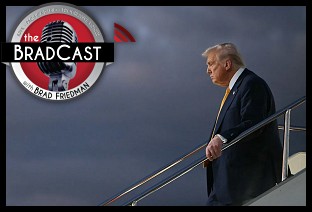 A Pretty Weak 'Strongman':
A Pretty Weak 'Strongman':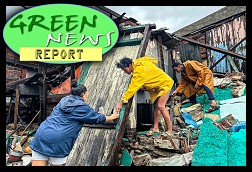 'Green News Report' 10/30/25
'Green News Report' 10/30/25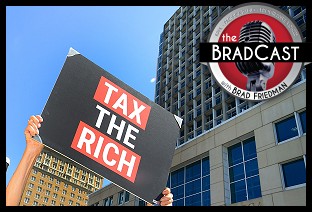 Proposal for 'Politically Viable Wealth Tax' Takes Shape in CA: 'BradCast' 10/29
Proposal for 'Politically Viable Wealth Tax' Takes Shape in CA: 'BradCast' 10/29 Monster Storm, Endless Wars, Gamed Elections: 'BradCast' 10/28/25
Monster Storm, Endless Wars, Gamed Elections: 'BradCast' 10/28/25 Let's Play 'Who Wants to Be a U.S. Citizen?'!: 'BradCast' 10/27/25
Let's Play 'Who Wants to Be a U.S. Citizen?'!: 'BradCast' 10/27/25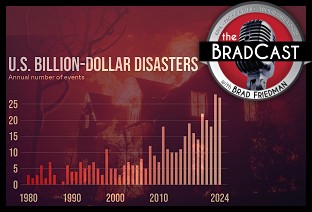 Exiled NOAA Scientists Resurrect Critical Disaster Database: 'BradCast' 10/23/25
Exiled NOAA Scientists Resurrect Critical Disaster Database: 'BradCast' 10/23/25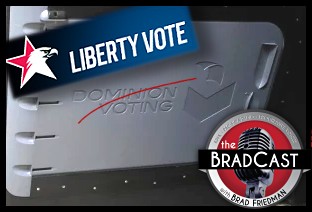 Trump-Allied GOP Partisan Buys Dominion Voting Systems: 'BradCast' 10/22/25
Trump-Allied GOP Partisan Buys Dominion Voting Systems: 'BradCast' 10/22/25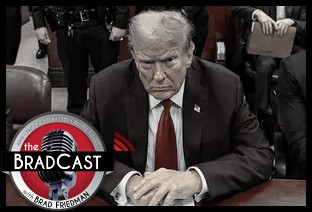 Trump, Republican Law(lessness) & (Dis)Order: 'BradCast' 10/21/25
Trump, Republican Law(lessness) & (Dis)Order: 'BradCast' 10/21/25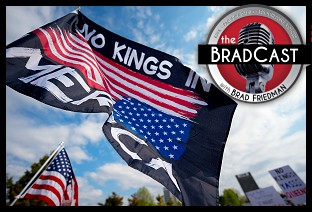 Celebrating 'No Kings': 'BradCast' 10/20/25
Celebrating 'No Kings': 'BradCast' 10/20/25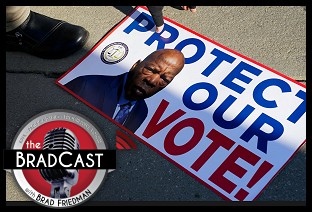 SCOTUS Repubs Appear Ready to Gut Rest of Voting Rights Act: 'BradCast' 10/16/25
SCOTUS Repubs Appear Ready to Gut Rest of Voting Rights Act: 'BradCast' 10/16/25
 VA GOP VOTER REG FRAUDSTER OFF HOOK
VA GOP VOTER REG FRAUDSTER OFF HOOK Criminal GOP Voter Registration Fraud Probe Expanding in VA
Criminal GOP Voter Registration Fraud Probe Expanding in VA DOJ PROBE SOUGHT AFTER VA ARREST
DOJ PROBE SOUGHT AFTER VA ARREST Arrest in VA: GOP Voter Reg Scandal Widens
Arrest in VA: GOP Voter Reg Scandal Widens ALL TOGETHER: ROVE, SPROUL, KOCHS, RNC
ALL TOGETHER: ROVE, SPROUL, KOCHS, RNC LATimes: RNC's 'Fired' Sproul Working for Repubs in 'as Many as 30 States'
LATimes: RNC's 'Fired' Sproul Working for Repubs in 'as Many as 30 States' 'Fired' Sproul Group 'Cloned', Still Working for Republicans in At Least 10 States
'Fired' Sproul Group 'Cloned', Still Working for Republicans in At Least 10 States FINALLY: FOX ON GOP REG FRAUD SCANDAL
FINALLY: FOX ON GOP REG FRAUD SCANDAL COLORADO FOLLOWS FLORIDA WITH GOP CRIMINAL INVESTIGATION
COLORADO FOLLOWS FLORIDA WITH GOP CRIMINAL INVESTIGATION CRIMINAL PROBE LAUNCHED INTO GOP VOTER REGISTRATION FRAUD SCANDAL IN FL
CRIMINAL PROBE LAUNCHED INTO GOP VOTER REGISTRATION FRAUD SCANDAL IN FL Brad Breaks PA Photo ID & GOP Registration Fraud Scandal News on Hartmann TV
Brad Breaks PA Photo ID & GOP Registration Fraud Scandal News on Hartmann TV  CAUGHT ON TAPE: COORDINATED NATIONWIDE GOP VOTER REG SCAM
CAUGHT ON TAPE: COORDINATED NATIONWIDE GOP VOTER REG SCAM CRIMINAL ELECTION FRAUD COMPLAINT FILED AGAINST GOP 'FRAUD' FIRM
CRIMINAL ELECTION FRAUD COMPLAINT FILED AGAINST GOP 'FRAUD' FIRM RICK SCOTT GETS ROLLED IN GOP REGISTRATION FRAUD SCANDAL
RICK SCOTT GETS ROLLED IN GOP REGISTRATION FRAUD SCANDAL VIDEO: Brad Breaks GOP Reg Fraud Scandal on Hartmann TV
VIDEO: Brad Breaks GOP Reg Fraud Scandal on Hartmann TV RNC FIRES NATIONAL VOTER REGISTRATION FIRM FOR FRAUD
RNC FIRES NATIONAL VOTER REGISTRATION FIRM FOR FRAUD EXCLUSIVE: Intvw w/ FL Official Who First Discovered GOP Reg Fraud
EXCLUSIVE: Intvw w/ FL Official Who First Discovered GOP Reg Fraud GOP REGISTRATION FRAUD FOUND IN FL
GOP REGISTRATION FRAUD FOUND IN FL

































